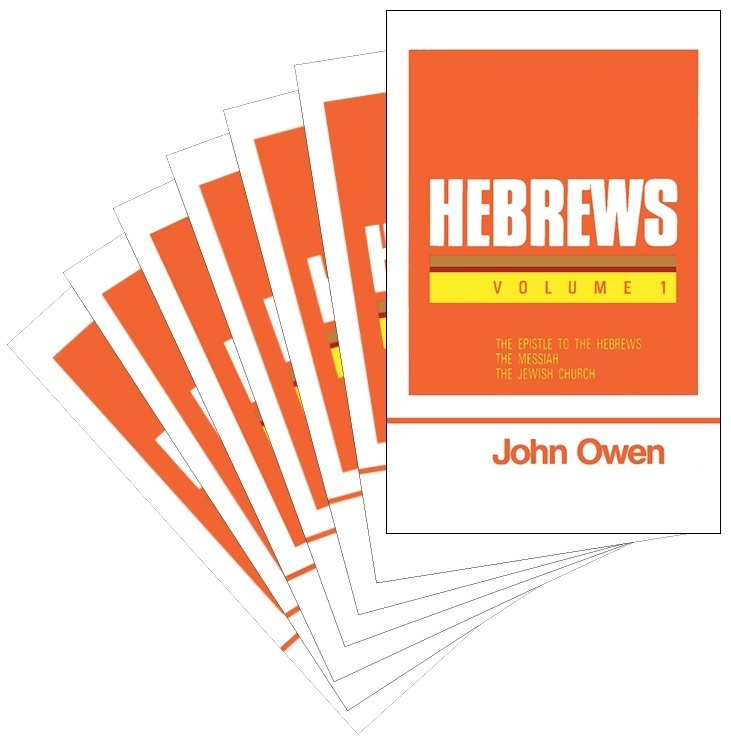How to Read John Owen: Part 3

Feb 8, 2017
 I know many pastors who bought John Owen’s seven-volume “commentary” on Hebrews who had high hopes of reading them while preaching through Hebrews, only to be daunted at the size of the work, the depth of the material, and the breadth of the matter. The temptation is simply to give up. However, C.H. Spurgeon wrote concerning this set, “Out of scores of commendations of this colossal work we select but one. Dr. Chalmers pronounced it ‘a work of gigantic strength as well as gigantic size; and he who hath mastered it is very little short, both in respect to the doctrinal and practical of Christianity, of being an erudite and accomplished theologian.” As we conclude our series on reading Owen (part 1, part 2), below are some thoughts on why and how to use Owen on Hebrews realistically and profitably.
I know many pastors who bought John Owen’s seven-volume “commentary” on Hebrews who had high hopes of reading them while preaching through Hebrews, only to be daunted at the size of the work, the depth of the material, and the breadth of the matter. The temptation is simply to give up. However, C.H. Spurgeon wrote concerning this set, “Out of scores of commendations of this colossal work we select but one. Dr. Chalmers pronounced it ‘a work of gigantic strength as well as gigantic size; and he who hath mastered it is very little short, both in respect to the doctrinal and practical of Christianity, of being an erudite and accomplished theologian.” As we conclude our series on reading Owen (part 1, part 2), below are some thoughts on why and how to use Owen on Hebrews realistically and profitably. Why Study Owen on Hebrews?
1. These volumes represent Owen at his best. They appeared between 1668-1684. Owen died in 1683. The Hebrews set is permeated with the mature thought and piety of a lifetime of labor in the Lord’s vineyard, and represents the best that Owen had to offer.
2. They contain profound exegesis of Scripture. Among the English Puritans, Owen practically stands in a category by himself as an exegete. This is not limited to his exposition of Hebrews. Owen provides detailed explanations of many passages of Scripture, particularly from the Old Testament, that are extremely valuable. Owen possessed a rare mastery both of Greek and Hebrew that enabled him to expound the Bible with clarity and power.
3. The Hebrews commentary warms the heart while instructing the mind. Owen explores nearly the entire realm of Christian theology in the context of sound exegesis. This is evident on every page of the work, but the preliminary “exercitations” are particularly value. His theological introduction to the epistle to the Hebrews will greatly help those wanting to understand historical argument of the book as well as its theological importance in the Bible as a whole. His treatments of the Messiah, the Jewish Church, and Christ’s Priestly office stir up devotion to Christ and connect the entire Bible under these themes. His Day of Sacred Rest is a needed challenge for today’s church, in which the Sabbath is becoming forgotten. This book also unfolds Owen’s teaching on the relation between the Mosaic covenant and the Covenant of Works more clearly than most other places in his writings. This may add clarity to some contemporary debates over this subject.
4. Owen’s treatment of Hebrews highlights the glory and beauty of new covenant worship. This is a recurring theme throughout the work. For example, his comments on Hebrews 7:1 and 7:7 include a significant treatment of the role of ordained ministers in public worship and of benedictions. His aim throughout is to press us to glorify and enjoy the Triune God more fully and to be excited about worship in light of the new covenant.
How to Use Owen on Hebrews
1. Use the expositions of the Greek text at the beginning of each section. Owen’s theological and practical analyses are so lengthy that, though always profitable, they can overwhelm anyone trying to keep up with him for a weekly sermon series. For example, he wrote 84 pages on Hebrews 1:1-2. However, his analyses of the original text of Hebrews rival most commentaries in skill and precision. In addition, Owen began each chapter of Hebrews with an insightful survey of the scope of the chapter. This will help you put together the general flow of the book.
2. Skim through lengthy sections, giving attention to discussions that will likely expand doctrines and applications that will be most relevant to you. The "Summary of Doctrinal and Practical Observations" at the end of volume two was designed to assist you in doing this. Verse by verse and section-by-section, it lays out what you will find treated in connection to every part of the epistle. This will enable you to plan ahead for subjects that may be more helpful to you than others.
3. Read and digest a little at a time. In spite of what the size of the work suggests, Owen is dense and brief. I have often profited more from five pages of Owen than from five volumes by other writers on the same subject.
4. Plan ahead in your reading. Preaching requires more than the fruit of weekly preparation. Every sermon reflects who the preacher is as a man and betrays the extent of his growth in the grace and knowledge of Christ in his life as a whole. The preacher’s prayerful reading beyond his weekly sermon preparation in large measure determines how profitable he will be in his weekly labors. Look at your text well in advance and begin digesting your material prayerfully and early.
5. Use the Scripture index in volume seven. The value of the Hebrews set is not limited to preaching through Hebrews. For example, when preparing a sermon on Haggai 2:6-7 (on the “shaking” of heaven and earth) I gained more profit from Owen’s exposition of this passage in Hebrews than from most commentaries on Haggai. While I was in seminary, our Hebrew professor required Owen’s exposition of Isaiah 7:10-16 (the “virgin birth” prophesy) for an exegesis paper. Passages in the index with blocks of text next to them likely mark full-scale treatments of those passages. Use them well.
Those disciplined enough to work through all seven volumes of Owen on Hebrews will bring forth fruit from it even to old age. However, even if you cannot read these volumes from cover to cover, then do not allow them to collect dust on the shelves. If you do not own this set, save up until you can afford it, or sell something else in order to get it. However, there is no virtue in owning Owen unless you make a plan to read him. “In all labor there is profit, but idle chatter leads only to poverty” (Prov. 14:23).
[This post was edited from a published article with Banner of Truth. Used with permission.]





